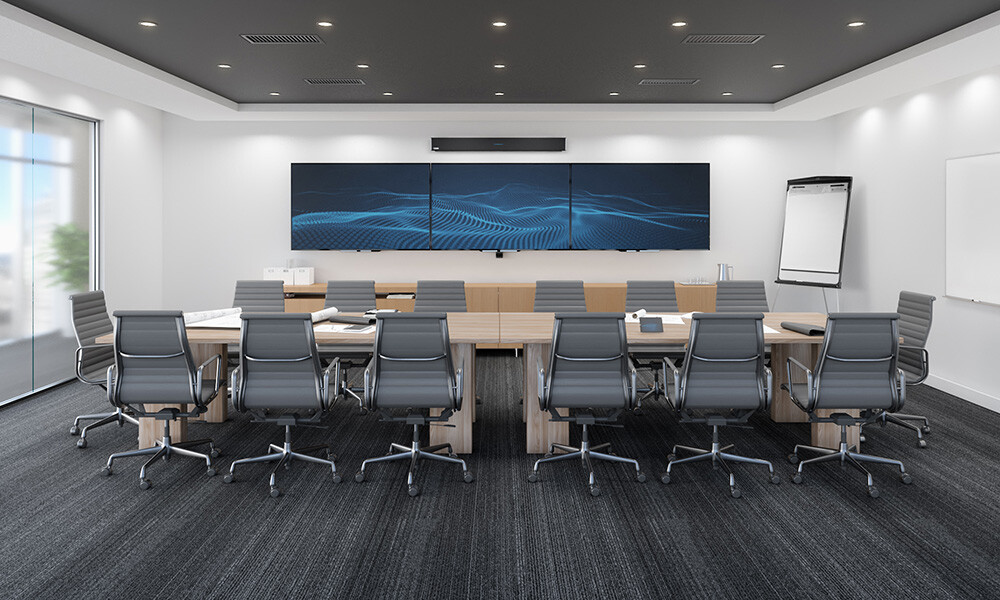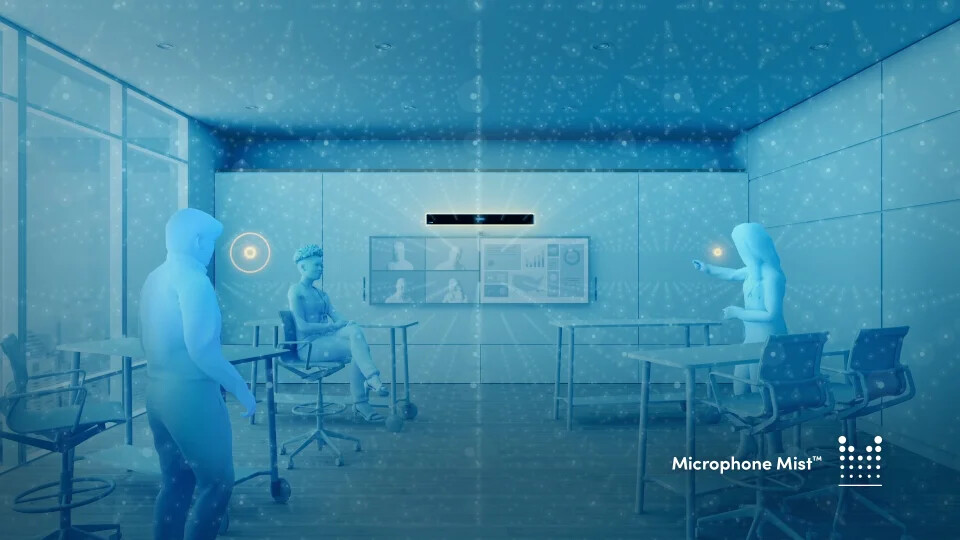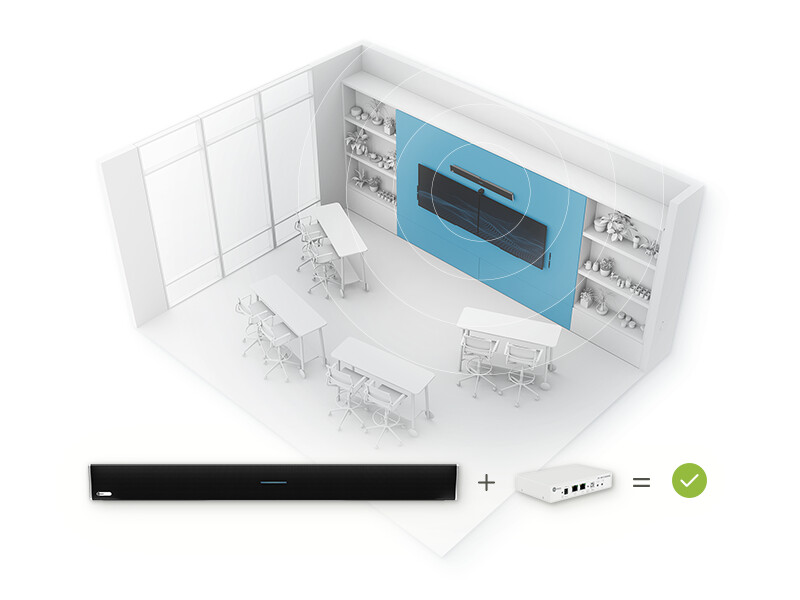Nureva HDL300 audio conference system, black












£4,918.80*


Product information
The HDL300 system is an integrated microphone and speaker bar that provides true full-room microphone coverage and clear, crisp sound in large rooms up to 7.6 x 7.6 metres - including meeting rooms, classrooms, flexible and studio spaces.
- Intelligent sound targeting uses algorithms to block out ventilation noise
- Position-dependent volume control for a natural listening experience
- Simultaneous capture of all virtual microphones for natural conversations
- Voice amplification mode amplifies the speaker's voice for all participants
- Camera tracking uses precise sound localisation for camera guidance
- Active Zone control for targeted microphone coverage
- Integrated signal processing without extra DSP
>>> Book a live online demo directly with the manufacturer here <<<

Full microphone coverage throughout the room
Like all Nureva® systems, the HDL300 is powered by patented Microphone Mist™ technology, which fills the room with thousands of virtual microphones. A single HDL300 provides true coverage of the entire room - compared to traditional systems that use multiple components and still have areas where people can't be heard. Continuous automatic calibration ensures your audio is always optimised - no technician required - even if you change the room layout.

Easy installation
Installing the HDL300 is simple and takes about 30 minutes. You attach the device to the wall with two screws, run a cable to the connection module and then another to a computer. Compare that to traditional multi-component systems that might involve selecting and installing multiple microphones, speakers, cables and a DSP - a process that can take days and require outside technicians.

Manage from anywhere
The HDL300 and all your Nureva devices can be managed from anywhere with the Nureva Console - our secure, cloud-based platform included with every system. Use it to remotely install firmware updates, check device status, analyse room data, adjust microphone coverage, access developer APIs and much more. You also get a 2-year subscription to Nureva Pro, which includes extended support hours, early hardware replacement and advanced Nureva Console features.

Compatibility
The HDL300 system is certified for Microsoft® Teams and Zoom and works with all other leading UC&C platforms. As a standard USB device, it also works with almost everything else you have in your rooms.

Technical data
| Name | Nureva HDL300 audio conference system, black |
|---|---|
| Article number | 1000029423 |
| GTIN/EAN | 0860006196738 |
| Manufacturer SKU | HDL300-B |
| Model name | HDL300 |
| Brand | Nureva |
| Product Type | Conference system |
| Speaker type | Speaker system |
| Inputs | 1x Ethernet , 1x USB-A Inputs HDMI: Digital connection for the transmission of picture & sound. Necessary for high-resolution picture quality (HDTV). Since HDMI 1.4 (High Speed) suitable for transmission of 3D content in Full HD. For high-resolution picture quality in UHD, 4K or HDR, the connection via HDMI 2.0a and higher is suitable. HDMI 2.1 or higher should be used from 120Hz refresh rate in 4K. VGA: The VGA connector is a 15-pin connector for analogue image transmission. It is also called DSub15 and is often found on notebooks and PCs. Compared to the other analogue connections, it offers good picture quality. It can be screwed to the input or output device and can be adapted to YUV with a suitable configuration. DisplayPort: The DisplayPort connection is a VESA-standardised connection for the transmission of image and sound data. In addition to HDCP encryption, DPCP is also supported. Due to its compact size, the connection is most commonly used in notebooks. An extra small variant is the MiniDisplayPort, which is used especially with Apple devices. DVI: DVI (Digital Visual Interface) is an interface for the transmission of video data. Only analogue signals can be transmitted via DVi-A, only digital signals via DVI-D and both types of signals via DVI-I. USB: USB (Universal Serial Bus) is used to control and manage the projector (USB-B). With some business devices, office files and images can also be presented directly with a USB stick or a mouse can be connected via the USB input (USB-A). Toslink: The Toslink connection is an optical signal connection that works on an optical fibre basis. It is used for the digital transmission of audio signals. The optical design offers a lower susceptibility to interference from external magnetic and electrical influences. The connection is mostly used in the area of DVD / Blu-ray players and comparable devices in connection with an AV receiver, if these work with dts or Dolby Digital signals. YUV: The YUV connection, also called Y Cb/Pb Cr/Pr or component connection, is an analogue video connection with three channels (light intensity and two colour channels). Qualitatively, it is the best analogue video connection. Component cable: The YUV connector transmits analogue signals over three cables (Y=black and white UV=colours). YUV is used to transmit HDTV and is compatible with Cinch, for example. S-Video: The S-Video connection is also called S-VHS or Hosiden connection. Compared to the Cinch video connection, it works with two channels (brightness/colour). In terms of quality, it is somewhat better than the Cinch video connection, but there are also limitations. These can be explained by the susceptibility of the signal, which is reflected in picture distortions, for example. Cinch: The cinch video connection is also called composite connection. To make it easier to recognise, it is usually sheathed in yellow. Since the transmission is only via one channel, the picture quality is on a low level. D-Sub15: The VGA connector is a 15-pin connector for image transmission on an analogue basis. It is also called DSub15 and is often found on notebooks and PCs. Compared to the other analogue connectors, it offers good picture quality. It can be screwed to the input or output device and can be adapted to YUV with a suitable configuration. RS232: The RS232 interface can be used to control or manage the projector. Mini Jack: With a single-pin Mini Jack, mono audio signals can be transmitted, with a two-pin stereo audio signals and with a three-pin stereo audio signals and image data can be transmitted. Scart: Scart is a connector that can be used to transmit analogue audio and video signals. It is compatible with other analogue connections such as RCA or S-Video. ARC: The audio return channel, also called ARC or audio return channel, was introduced with HDMI version 1.4 to reduce the amount of cabling between HDMI components. The audio return channel runs via the existing HDMI cable. Therefore, an additional cable for the sound no longer needs to be connected. However, both devices must support ARC. All audio file formats that are also transmitted via the SPDIF interface can be transmitted via the audio return channel. These include Dolby Digital, Digital Theatre Sound and PCM audio. As an example, a connection between a TV (including receiver) and an AV receiver could be made via an HDMI cable. The sound from the TV is fed back via the HDMI cable. Previously, an additional digital cable (coaxial or Tos-Link) was required for the audio signals. |
| Product width | 152.4 cm |
| Product height | 14.9 cm |
| Product depth | 9 cm |
| Weight | 8.2 kg |
| Colour | Black |
| Condition | New |
| Warranty | 24 Month |
| Warranty type | Bringin service Service and support information |
Manufacturer's warranty information:
Here you will find more detailed information on the different types of warranty. Please refer to our manufacturer overview for contact details and warranty conditions for the corresponding warranty claim. Statutory warranty rights are not restricted by an additional manufacturer's warranty. Our liability for defects is governed by law. Defect rights can be claimed free of charge.


